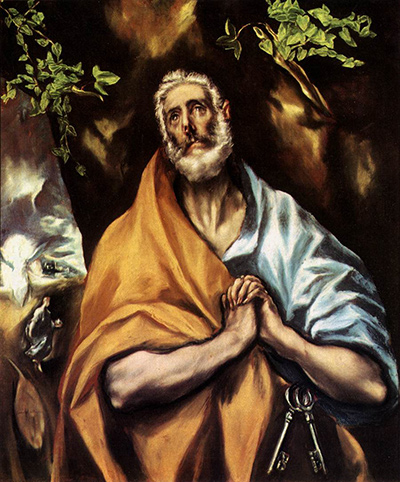St Peter in Penitence was painted during the 1580s by El Greco. Saint Peter appears in several works by El Greco. In each painting, the apostle is depicted relatively consistently with a white beard and white hair. He is usually show wearing a yellow cloak over a blue tunic.
St Peter in Penitence is one of at least six versions created by the Greek artist. In the oil on canvas painting, Saint Peter looks up to the heavens with teary eyes while his hands are clasped together in prayer. The painting's turbulent background shows Mary Magdalene returning to find the empty tomb of Jesus. St. Peter in Penitence represents the apostle after hearing of Jesus's resurrection from an angel. Part of the Bowes Museum's collection at Bernard Castle in the United Kingdom, the original St. Peter in Penitence measures 90 by 109 centimetres.
Another famous painting with the apostle as the central subject is The Penitent St. Peter, which was completed by El Greco between 1590 and 1595. The painting is one of El Greco's most famous images of devotion and Saint Peter. The oil on canvas again shows a repentant Saint Peter, this time distraught about denying his relationship with Jesus when questioned before the crucifixion. He is set in front of a dark tree trunk. His expression and posture reflect distress. The background also shows Mary Magdalene returning from Jesus’s tomb. An angel surrounded by white is also represented. After hearing of his resurrection from an angel, she is walking towards Saint Peter to share the news.
The theme and imagery of The Penitent St Peter and St. Peter in Penitence are similar. There are, however, subtle differences. The more refined The Penitent St. Peter has much greater detail. The apostle’s garments are also more vivid in colour and texture, with the golden robe more predominantly shown on Saint Peter. Both paintings showcase a touching sense of humanity often found in El Greco’s paintings, particularly in the expressions of figures illustrated in his work. They also represent and reflect concerns during the Counter-Reformation. Catholics against the Protestant Reformation used Saint Peter’s penitence after Jesus’s crucifixion to justify the sacrament of confession, an act challenged by Protestants.
El Greco or The Greek was born Doménikos Theotokópoulos in 1541. His spent his first years in Crete when the Greek Island was part of the Republic of Venice. Crete was also the centre for the Post-Byzantine school of art, which El Greco studied during his early career. At the age of 26, the painter and sculptor moved to Italy and settled in Venice. By 1577, he settled in Toledo and continued to paint and study in Spain.
During his time in Spain, he became one of the leading artists of the Spanish Renaissance. At the same time, much of his acclaim came long after his death. Most contemporaries criticised El Greco’s work since they often deviated from popular principles of Renaissance. Many of his figures did not reflect the elegance and attention to proportion revered by Renaissance artists. Instead, El Greco’s paintings often featured distorted and elongated figures in tormenting scenes.
After his death in 1614, El Greco was recognised as an early innovator of Expressionism and Cubism. His style and work influenced several painters that followed, such as Paul Cézanne, Édouard Manet, Pablo Picasso and Jackson Pollock. Poets and writers were also influenced by El Greco and his works, including Rainer Maria Rilke and Nikos Kazantzakis.




